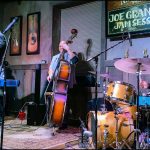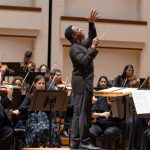October 19 & 21, 2023
Atlanta Symphony Hall, Woodruff Arts Center
Atlanta, Georgia – USA
Atlanta Symphony Orchestra
Lidiya Yankovskaya, conductor; Amjab Ali Khan, Amaan Ali Bangash & Ayaan Ali Bangash, sarod; Shane Shanahan, percussion.
Gabriela Lena FRANK: Elegía Andina (“Andean Elegy”)
Amjad Ali KHAN: Samaagam
Sergei PROKOFIEV: selections from Romeo and Juliet
Mark Gresham | 23 OCT 2023
The second installment of the Atlanta Symphony Orchestra’s 2023-24 classical subscription series posited a culture-melding East-West theme (though “Global North-South theme” might be the more appropriate 21st-century way of expressing it), and we got to hear how that played out this past Thursday evening when guest conductor Lidiya Yankovskaya took the podium to lead the ASO in works by Gabriela Lena Frank, Amjad Ali Khan, and Sergei Prokofiev. The composer in the middle, preeminent sarod player Amjad Ali Khan, was also the featured guest performing artist along with his ensemble members: sarod players Amaan Ali Bangesh and Ayaan Ali Bangesh, and percussionist Shane Shanahan.
The concert opened with Elegia Andina (“Andean Elegy”) by Gabriela Lena Frank (b. 1972), a symphonic work from 2000 that uses woodwind instruments extensively, and some daring choices recalling even Stravinsky and his Rite of Spring, sometimes with quite literal citations, dense and elaborated.

The final chord of “Elegia Andina” by Gabriela Lena Frank, shown in condensed scoring. (click to enlarge)
The piece culminates in a featured duo flute cadenza (beginning meas. 354), its final bars underscored by rolls on timpani and suspended cymbal, then a final loud pizzicato chord in the strings just before they play arco at measure 359 (Tempo I, ♩=72). From that climax, the piece begins to wind down and relax, with the final, quiet chord being a flute harmonic (on a high E) above low, densely packed strings, a sound which is, at last, brushed away by a lightly scraped suspended cymbal.
Although it is not a piece that will change the course of music history, Elegia Andina is a credible and genuinely engaging work. This was the second time the ASO had performed it. The first was in June 2021, with Miguel Harth-Bedoya conducting.
Next up was a much longer work, Samaagam by Amjad Ali Khan, which featured Khan’s aforementioned quartet of sarod players plus hand percussion (in this performance, Shanahan played a Darbuka, a Kanjira, and a frame drum). The title Samaagam comes from a Sanskrit word meaning “confluence” or “flowing together.” In combining these instruments with a symphony orchestra, Khan posits combining the features of Indian classical music with elements of “pre-equal temperament” Western classical music (which one must assume means early Baroque and its antecedents, but I would wager the earlier linear thinking of Renaissance and precedent approaches to music theory would be even more compatible with ragas).
But rather than overly-heady argumentation about commonalities in culturally different music theories, let’s turn instead to something more tangible for the average listener: the principal solo instrument in question.
The sarod, a fretless stringed instrument, holds a significant place in Hindustani music on the Indian subcontinent, ranking alongside the sitar in popularity and prominence.
The term “sarod,” introduced during the late Mughal Empire, predates the musical instrument itself. Its origins can be traced to the Persian noun “sorūd” (“song,” “melody,” or “hymn”) and the verb “sorūdan” (“to sing,” “to play,” and “to compose”).

The ASO, conducted by Lidiya Yankovskaya, performs Amjad Ali Khan’s “Samaagam” with the composer and he ensemble of sarod players and percussion. (credit: Rand Lines)
That is rather straightforward, compared to differing historical narratives surrounding the origins of the instrument, which are often fraught with contradictions and disputes. One account (most relevant to this concert) attributes its invention to guest artist Amjad Ali Khan’s direct ancestors, beginning with Mohammad Hashmi Khan Bangash, who arrived in India with the Afghan rubab in the mid-18th century and served as a court musician to the Maharajah of Rewa (now in Madhya Pradesh). His descendants transformed the rubab into the sarod as it is known today.
What is considered the instrument’s current form emerged around 1820. Notable improvements were introduced in the 20th century by Allauddin Khan and his brother Ayet Ali Khan, who expanded the number of chikari (drone) strings and tarafdar (sympathetic) strings. A contemporary sarod typically features a lute-like structure with 17 to 25 strings—four or five main strings for melodic play, two chikari, and nine to eleven sympathetic strings.
While Amjad Ali Khan adheres to this traditional design, he has made minor adjustments to his instruments that have become standard for his followers. Word is that his sarods are crafted from teak wood with a soundboard of goat skin stretched across the resonator’s face and a chrome or nickel-plated cast steel fingerboard, with six pegs in the main pegbox, two rounded chikari pegs, and 11 tarafdar.
Now to Khan’s music for Thursday’s concert:
Samaagam is broadly structured in three sections, each comprised of sets of ragas. (A raga is a melodic framework for improvisation in Indian classical music, somewhat akin to a melodic mode in Western classical music.)
The first section opened with the raga Ganesh Kalyan, followed by Subhalakshmi and Swar Samir. (Ganesh is the Hindu elephant god of good luck and the remover of obstacles, so of course Ganesh Kalyan is the first raga performed.) All three of these ragas were originally conceived and developed by Khan.
Seven traditional ragas in quick succession comprised the second section, the first, Maarva, is associated with sundown, the following five being evening or night ragas, and the final, Basant Megh, a harbinger of rain.
The third section explored three final ragas: Khamaj, Buphali, and Bhairavi. The last of these, traditionally considered a morning raga, is intended to be played at dawn at the end of an all-night concert. Since we don’t tend to have all-night concerts in the ASO classical series, hearing Bhairavi as the final raga of Samaagam fulfills at least a nod to the intent of closure.
But the important part: How did it all sound?
It was beautiful music, for certain, and those who can sit back and let themselves be immersed in the music without wondering too much “where it is going” are going to likely feel more in tune with the experience. But for many listeners whose sphere is entirely in the Euro-American classical traditions, the phrase may apply: “Half as long would be twice as nice.” It depends on where you are willing and able to place your mind (with ears attached, of course).

Sarod players Amaan Ali Bangash, Amjad Ali Khan, and Ayaan Ali Bangash perform with the Atlanta Symphony Orchestra, October 19, 2023. (credit: Rand Lines)
Sergei Prokofiev composed his four-act ballet Romeo and Juliet, Op. 64, based on the play by William Shakespeare, in 1935, then revised it substantially for its Soviet premiere in early 1940. He also derived three orchestral suites from it and a solo piano suite (Romeo and Juliet: Ten Pieces for Piano, Op. 75).
That doesn’t mean a conductor has to pick one of the suites and program it “as is.” Another viable option is to mix and match selections from the original ballet and the three orchestral suites, which is what Yankovskaya and the ASO did for the second half of Thursday’s program, billed simply as “Selections from Romeo and Juliet.”
This particular assemblage opened with the first two movements of Suite No. 2, with a rendition of “The Montagues and Capulets” that was weighty and deliberate rather than pressing urgently forward (the latter is often the case), followed by “The Young Juliet.” The sequence then turned to the “Balcon Scene” (from Suite No. 1), “Morning Dance” (from Suite No. 3), and “Romeo at Juliet’s Grave” (Suite No. 2) before ending with the final two scenes of Act II from the complete ballet: “Romeo Resolves to Avenge Mercutio’s Death” and “Cortège with Tybalt’s Body” (Scenes 35 and 36). It proved an effective lineup of Prokofiev’s music that went over rather well.
Unfortunately, the audience on Thursday evening seemed a bit on the sparse side, at least from my vantage point. Nevertheless, the program offered an insightful, culturally comparative experience, showcasing the power of music to transcend boundaries for those open to the journey. ■
EXTERNAL LINKS:
- Atlanta Symphony Orchestra: aso.org
- Lidiya Yankovskaya: lidiyayankovskaya.com
- Amjab Ali Khan: sarod.com

Read more by Mark Gresham.







.png)